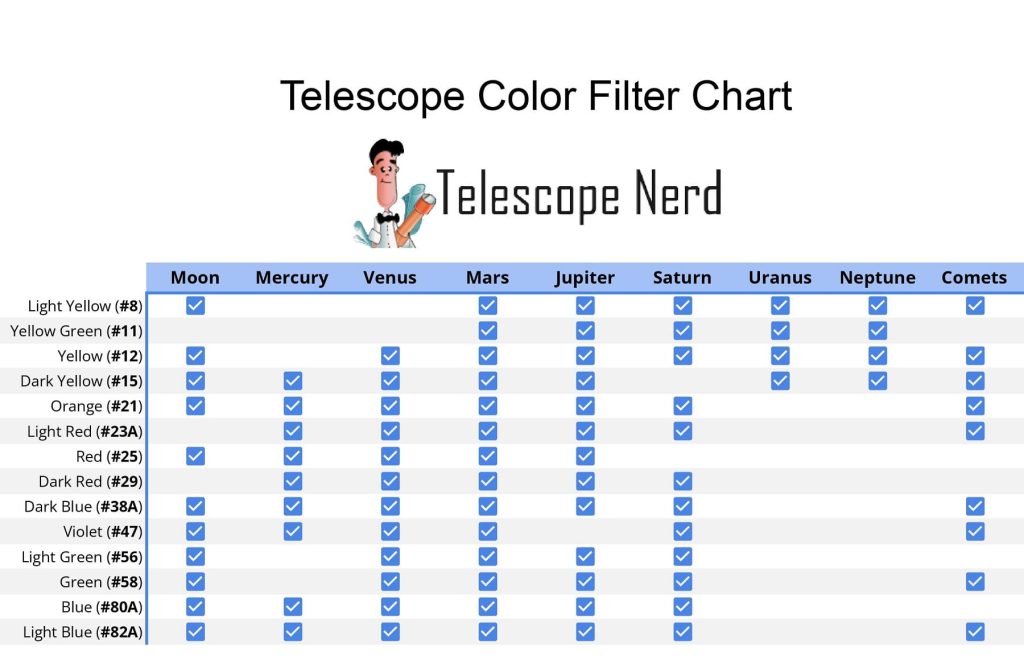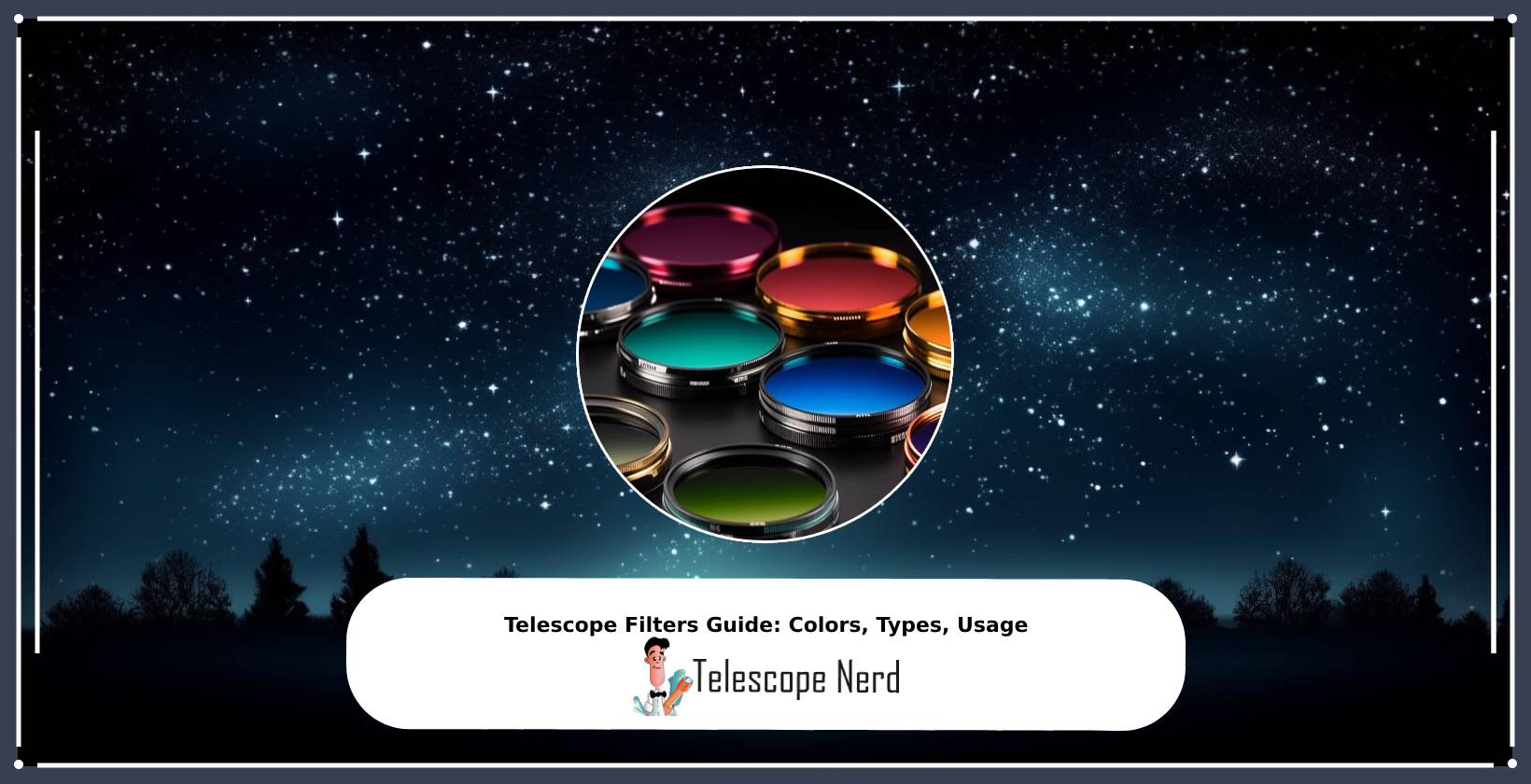Telescope Filters Guide: Types, Colors, Usage
A telescope filter is a part of a telescope that modifies wavelengths of light to enhance the visibility of celestial objects. Telescope filters function by selectively transmitting certain wavelengths of light. This selectivity enhances contrast and detail while protecting the eyes from excessively bright objects. Knowing which telescope filter to use for a specific observation allows astronomers to optimize the clarity and brightness of an image.
A multitude of filter types exist, each tailored to distinct observational needs with a unique color and usage. Charts are often used to select the right filter, providing insights into the optimal filters for specific celestial observations. These filters are crafted from specialized glass or plastic materials, with each material affecting light transmission differently. For those inclined towards customization, DIY options are available for some filters.
What Are the 5 Types of Telescope Filters?
The type of telescope filter refers to a variety of designs, each with unique observational applications, which significantly impact the clarity, detail, and overall quality of the view. Each filter type is designed to address specific challenges or enhance certain celestial features.
By understanding and selecting the appropriate filter type, astronomers optimize their observations and capture the most detail. The five most commonly used types are shared below.
- Solar
- Moon
- Light Pollution
- Color
- Ultra High Contrast
1. Solar Filter
A solar filter is a specially designed optical filter that reduces the intensity of sunlight to a safe and manageable level, allowing for direct viewing of the sun. For specific solar events, like solar eclipses, a specialized solar filter called an “eclipse filter” is often used to ensure safe observation.
The solar filter works by blocking a significant portion of the sun’s intense light, including harmful infrared (IR) and ultraviolet (UV) rays. It only allows a tiny fraction (usually 0.001% or less) of the sun’s light to pass through, ensuring that the viewer is able to observe the sun without damaging their eyes.
The solar filter is primarily used for viewing the sun, especially during solar events like solar eclipses, sunspots, and transits. It’s essential to use this filter during these events to prevent permanent eye damage. The primary benefit of a solar filter is that it provides a safe means to observe the sun in detail, revealing features that are otherwise too bright to view. While there are commercial solar filters available, some enthusiasts opt for DIY options using specialized solar film. To use a solar filter, it should be securely mounted at the front end of the telescope, ensuring no unfiltered light will enter the telescope.
2. Moon Filter
A moon filter is an optical filter that reduces the brightness of the moon’s light, enhancing the contrast and allowing for more detailed observation of lunar features.
The lunar filter operates by selectively dimming the intense reflected sunlight from the moon’s surface. This dimming effect helps reveal the finer details of the moon’s terrain, such as craters, rilles, and mountains, which will otherwise be washed out by the moon’s brightness.
Primarily, lunar filters are used for observing the moon, especially during its brighter phases like the full moon or gibbous phases. Using a lunar filter during these times significantly improves the viewing experience by reducing glare and enhancing surface details.The main advantage of a lunar filter is that it allows astronomers and enthusiasts to observe the moon with increased clarity and contrast. To utilize a lunar filter, it should be securely attached to the eyepiece of the telescope or binoculars, ensuring that the viewer gets the best possible view of our natural satellite.
3. Light Pollution Reduction Filter
A light pollution reduction (LPR) filter, or city light filter, is an optical filter designed to enhance the visibility of celestial objects by suppressing the unwanted wavelengths of light commonly found in urban environments.
The light pollution filter works by selectively blocking specific wavelengths of light that are produced by streetlights, neon signs, and other artificial light sources. By doing so, the LPR filter helps to increase the contrast between the night sky and celestial objects, making them stand out more prominently against the background.
Primarily, LPR filters are used by astronomers and stargazers who are observing the night sky from locations with significant ambient light, such as cities or populated suburbs. Using an LPR filter in these conditions will reduce the skyglow and allow fainter objects to become more visible. The main advantage of a light pollution filter is that it enables observers to get clearer and more detailed views of stars, galaxies, and nebulae, even from light-polluted areas. The light pollution filter should be securely attached to the eyepiece of the telescope.
4. Color Filter
A color filter is an optical filter that isolates specific wavelengths of light, allowing only certain colors to pass through while blocking others.
Color filters function by limiting certain wavelengths to emphasize specific features and details of celestial objects. For instance, they enhance the contrast of planetary surface details or highlight certain atmospheric phenomena. Color filters are primarily used for planetary observation.
Color filters are commonly used in conjunction with a color filter chart, which guides observers on which filter to use for specific planets. For example, a blue filter is often used to enhance the details of Jupiter’s cloud bands, while a red filter highlights the polar ice caps on Mars. The main advantage of color filters is their ability to bring out subtle details in celestial objects that are overlooked in white light. To use a color filter, it should be securely attached to the eyepiece of the telescope, ensuring optimal viewing results.
5. Ultra High Contrast Filter
An Ultra High Contrast (UHC) filter is an optical filter designed to enhance the visibility of deep-sky objects by selectively allowing specific wavelengths of light to pass through while blocking the majority of other wavelengths, particularly those associated with artificial light pollution.
The UHC filter works by emphasizing the emission lines of hydrogen and oxygen, which are common in many nebulae, while greatly reducing the effects of city lights, streetlights, and other sources of light pollution.
These filters are primarily used for observing nebulae and other deep-sky objects from locations with significant ambient light or where light pollution is a concern. By using a UHC filter, astronomers achieve better contrast and detail in their observations, making faint nebulae more visible against the background sky. The main advantage of the UHC filter is its ability to significantly improve the visibility and detail of deep-sky objects in less-than-ideal viewing conditions. To utilize a UHC filter, it should be securely attached to the eyepiece of the telescope, ensuring enhanced views of the cosmos.
How to Use a Telescope Color Filter Chart?
A telescope color filter chart provides guidance on which color filter to use to enhance specific features on a planet or object. Each color corresponds to a particular wavelength of light, and by using the appropriate filter, observers emphasize or diminish certain details.
The chart shows the associated Wratten numbers next to the color filter. Wratten numbers are a standardized system that categorizes filters based on their color and the type of light they transmit. These numbers make it easier for astronomers to select the right filter without having to remember the specific color or its properties.

To use a telescope color filter chart, identify which planet or celestial body they intend on viewing. Locate the determined object on the chart. The “checked” rows correspond with the recommended color filter and Wratten number found on the left side.
Based on the chart’s recommendation, select and attach the appropriate filter. Telescope filter wheels allow astronomers to quickly switch between different filters without needing to remove them manually. Once the filter is in place, the chosen filter will enhance the contrast and definition of the image.
While color filters are beneficial for observing planets and some other celestial objects, they are not suitable for sun observation. When observing the sun, one must use a dedicated solar filter to protect their eyes and equipment from the sun’s intense light.
How to Make a DIY Solar Filter For a Telescope?
DIY solar filters are commonly used due to their cost-efficiency and flexibility. A DIY approach provides customizability for specific telescope sizes and is often a satisfying project for astronomy enthusiasts. However, crafting a solar filter requires precision and caution, as the sun’s intense rays cause irreversible eye damage if viewed incorrectly.
The foundational material for a DIY solar filter is a solar viewing film, such as the Baader AstroSolar Safety Film. This film selectively permits the safe wavelengths of sunlight while blocking the harmful ones, protecting the observer’s eyes.
To create a filter, trace the telescope cover onto a piece of cardboard. Then, draw another circle with an additional one-inch radius and cut the cardboard along both lines. Repeat this process on a second piece of cardboard, using the first as a template. The resulting cardboard rings will secure the filter. Next, trace the exterior of the cardboard ring onto the solar film and cut it along the line. Glue the film onto one of the cardboard rings, ensuring there are no gaps for light to pass through. To secure the film, glue the second piece of cardboard in line with the first.
A mount for the film is constructed by wrapping construction paper around the circumference of the telescope and gluing or taping the paper together to fit securely. Finally, glue this cylinder to the cardboard. This tube should snugly fit over the telescope’s end.
Before any solar observation, it’s paramount to test the filter. Aim the telescope at a bright indoor light to ensure no light breaches the film. If any light seeps through, the filter is not safe and should be reconstructed.
Are All Filters Compatible With All Telescope Eyepieces?
No, not all filters are compatible with every telescope eyepiece, as compatibility depends on the design and size of both elements. An eyepiece is the part of a telescope that one looks through, serving to magnify the image produced by the telescope’s primary optics. For a filter to be compatible with an eyepiece, the thread sizes must match. The thread sizes typically come in either 1.25 inches (31.75 mm) or 2 inches (50.8 mm). If the filter size is compatible, it is able to be attached by screwing it onto the bottom of the eyepiece.
Is it Possible to Attach a Filter to the Barlow Lens?
Yes, it is possible to attach a filter to a Barlow lens. A Barlow lens is an optical element used in telescopes to increase the effective focal length, thereby magnifying the image without needing to change the eyepiece.
Most Barlow lenses include threads at the bottom, designed to accommodate standard filters, such as those with 1.25-inch or 2-inch sizes. When attaching a filter, ensure the thread sizes of the Barlow and filter match, then gently screw the filter onto the Barlow lens.

